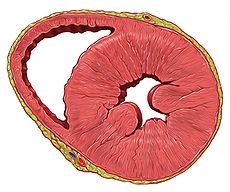
If you have a family history of heart disease, then the risk of left ventricular hypertrophy is greater than someone without such a history
Left ventricular hypertrophy (LVH) simply means that the larger muscle of the main cardiac pumping chamber (left ventricular muscle) has grown in size. This occurs as a result of a buildup of fatty deposits on the inner wall of the left ventricular muscle, leading to enlargement and thickening. This can occur over time if the primary left ventricular muscle must work excessively. As such, this portion of the heart has to be highly functional in order to properly pump oxygen-rich blood throughout the body.
In some cases of heart disease, left ventricular hypertrophy also occurs after the onset of heart failure. In these cases, heart failure is an underlying condition that is not caused by coronary artery disease. When left ventricular failure occurs, it often leads to a failure of the left ventricular muscle, leading to increased left ventricular mass.
Left ventricular mass is associated with reduced risks of congestive heart failure, stroke, and heart attack. As such, it is one of the most effective ways of preventing a number of serious conditions. Unfortunately, left ventricular mass also increases the risk of heart failure. As a result, if left ventricular dysfunction is present, the risk of left ventricular hypertrophy increases. Left ventricular dysfunction is usually diagnosed through electrocardiogram (ECG) or echocardiography (EKG).
When left ventricular muscle is damaged, a heart failure condition can result. It is not possible for any patient to survive without a healthy heart. Although the heart cannot work properly without the ventricular muscle, it is not always necessary for the patient to die if left untreated. A heart failure can be caused by several factors, including coronary artery disease, hypertension, congestive heart failure, hyperthyroidism, diabetes mellitus, or congenital heart diseases.
In addition to coronary artery disease, hypertension can also be caused by other factors. Such factors include cigarette smoking, high cholesterol levels, a sedentary lifestyle, poor diet, and unhealthy weight. Obesity is also an important factor; overweight can lead to heart failure because excess tissue and fat in the abdominal region can compress the heart muscle wall, reducing blood flow.
People who are overweight also have a higher risk of developing left ventricular hypertrophy because they create a pressure build up on the ventricular wall, causing a weakening of the muscle and decreasing the ability to contract. Obesity can be a major factor in heart failure because it makes it harder for the muscle to contract, thus reducing the amount of blood pumped to the lungs.
Another factor that can cause left ventricular hypertrophy is abnormal development of the ventricular wall due to the lack of growth of new cells. This occurs when the valve wall becomes blocked due to damage or injury. This can be caused by many different factors, such as congenital heart diseases, heart valve disease, or tumors.
Left ventricular hypertrophy may also be a sign of heart failure; when left untreated, this condition can eventually cause irreversible damage to the organ, which can lead to death. Left ventricular failure is more common in people with left ventricular failure than in people who have a normal heart function.
Left ventricular failure may result from a heart attack, but it may also result from problems like heart valve or cardiac arrhythmia. Symptoms of heart failure include palpitations, pain in the chest, dizziness, shortness of breath, fatigue, and loss of appetite.
Left ventricular hypertrophy, if left untreated, can also cause heart failure. Some symptoms of heart failure include: arrhythmias, increased blood pressure, fluid accumulation in the legs, irregular heartbeat, and heart failure, and chest pain in the left upper right side of the chest.
Left ventricular hypertrophy can also be caused by a problem with the heart valves. If a malfunction or blockage of the heart valves is present, the ventricular wall will begin to grow and enlarge, causing a weak and malformed heart shape, increasing the risk of heart failure. The left ventricular wall of the heart will also become thicker as it grows; this weakens the muscle mass, making it difficult to pump the right amount of blood to the lungs.